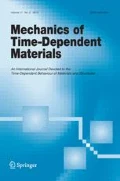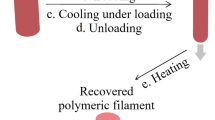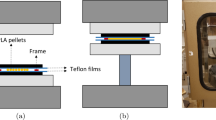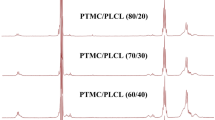Abstract
Poly(lactic-co-glycolic acid) (PLGA) is one of the most prominent bioresorbable materials, currently used in several medical applications (screws, craniofacial plates etc.). Looking to extend the knowledge about the thermomechanical behavior of bioresorbable medical materials, this research presents a series of experiments and results based on nonhomogeneous compression tests for the polymer PLGA 85/15. Instead of focusing on tensile and bending conditions for compression-molded products, such as usually presented in the literature, attention is given to compression tests and samples machined from injection-molded parts. Additionally, PLGA strain rate sensitivity, which is an issue less discussed in the literature, is analyzed. In the current study, this material is tested by observing the main features related to resorbable medical materials. The effects of a material heat treatment that are associated with PLGA shape-memory properties are investigated. Differential scanning calorimetry (DSC) was also employed in the thermal characterization. A finite element analysis of the compression testing provides a complementary overview of the mechanical behavior of PLGA 85/15. Results indicate that PLGA has a linear rate-insensitive response for small strains but presents a strong rate dependence for strains beyond the material yielding. PLGA shows a remarkable post-yielding strain-softening behavior, with a steep descent slope. Samples present significant mechanical changes after heat treatment at temperatures above \(T_{g}\), with reduction of 35% in the material elastic modulus and 30% in the upper-yielding stress and no significant changes for further heat-treatment procedures. DSC analysis confirmed the existence of significant residual stress in PLGA specimens. Mechanical deformation and manly heat treatment seem to reduce this residual stress caused by molecular orientation and rapid solidification. Finally, finite element simulations show that the limit of the homogeneity hypothesis is associated with the yield strain, after which highly non-uniform stresses develop.












Similar content being viewed by others
References
Ames, N.M., Srivastava, V., Chester, S.A., Anand, L.: A thermo-mechanically coupled theory for large deformations of amorphous polymers. Part II: Applications. Int. J. Plast. 25(8), 1495–1539 (2009)
Arruda, E.M., Boyce, M.C., Jayachandran, R.: Effects of strain rate, temperature and thermomechanical coupling on the finite strain deformation of glassy polymers. Mech. Mater. 19(2–3), 193–212 (1995)
Bergstrom, J.S.: Mechanics of Solid Polymers. William Andrew Publishing (2015)
de Castro, P.B., Fancello, E.A.: Coupled ductile–hydrolytic damage model based on variational constitutive updates. Comput. Methods Appl. Mech. Eng. 323, 202–229 (2017)
Farias, J.M.C., Stainier, L., Fancello, E.A.: A variational framework for the modeling of glassy polymers under finite strains. Contin. Mech. Thermodyn. (2019). https://doi.org/10.1007/s00161-019-00809-8
Gruber, J.A.: Accurate data reduction for the uniaxial compression test. Exp. Tech. 42(2), 209–221 (2017)
Jerabek, M., Major, Z., Lang, R.: Uniaxial compression testing of polymeric materials. Polym. Test. 29(3), 302–309 (2010)
Kuhn, H.: Uniaxial compression testing. In: Kuhn, H., Medlin, D. (eds.) ASM Handbook, vol. 8. Mechanical Testing and Evaluation, vol. 8, pp. 143–151. ASM International, Materials Park (2000).
de Melo, L.P., Salmoria, G.V., Fancello, E.A., de Mello Roesler, C.R.: Influence of processing conditions on the mechanical behavior and morphology of injection molded poly(lactic-co-glycolic acid). Int. J. Biomater. 85, 15 (2017a)
de Melo, L.P., Salmoria, G.V., Fancello, E.A., Roesler, C.R.M.: Effect of injection molding melt temperatures on plga craniofacial plate properties during in vitro degradation. Int. J. Biomater. 2017, 1256537 (2017b). https://doi.org/10.1155/2017/1256537
Pietrzak, W.S.: Rapid cooling through the glass transition transiently increases ductility of PGA/PLLA copolymers: a proposed mechanism and implications for devices. J. Mater. Sci., Mater. Med. 18(9), 1753–1763 (2007)
Pietrzak, W.S.: Mechanical and geometric stability of shape-adapted bioabsorbable plates. J. Craniofac. Surg. 23(1), 11–12 (2012)
Pietrzak, W.S., Eppley, B.L.: An experimental study of heat adaptation of bioabsorbable craniofacial meshes and plates. J. Craniofac. Surg. 18(3), 540–545 (2007)
Pietrzak, W.S., Sarver, D.R., Bianchini, S.D., D’Alessio, K.: Effect of simulated intraoperative heating and shaping on mechanical properties of a bioabsorbable fracture plate material. J. Biomed. Mater. Res. 38(1), 17–24 (1997)
Pietrzak, W.S., Caminear, D.S., Perns, S.V.: Mechanical characteristics of an absorbable copolymer internal fixation pin. J. Foot Ankle Surg. 41(6), 379–388 (2002)
Salmoria, G.V., Vieira, L.F., Gindri, I.M., Roesler, C.R.M., Fancello, E.A.: Properties of injection-molded poly (l-co-d,l-lactic acid) using different melt temperatures and stress concentrator in the specimen geometry. Int. J. Adv. Manuf. Technol. 98, 2231–2237 (2018)
Smit, T.H., Engels, T.A.P., Söntjens, S.H.M., Govaert, L.E.: Time-dependent failure in load-bearing polymers: a potential hazard in structural applications of polylactides. J. Mater. Sci., Mater. Med. 21, 871–878 (2010)
Sonnenhohl, A.: Desenvolvimento e implementação de procedimentos experimentais para a caracterização mecânica de polímeros termoplásticos, estudo de caso: UHMWPE. Master’s thesis, Departamento de Engenharia Mecânica, Universidade Federal de Santa Catarina (2015)
Sun, L., Huang, W., Ding, Z., Zhao, Y., Wang, C., Purnawali, H., Tang, C.: Stimulus-responsive shape memory materials: a review. Mater. Des. 33, 577–640 (2012)
Xiao, R., Nguyen, T.D.: Thermo-mechanics of amorphous shape-memory polymers. Proc. IUTAM 12, 154–161 (2015)
Xu, J., Song, J.: Polylactic acid (PLA)-based shape-memory materials for biomedical applications. In: Shape Memory Polymers for Biomedical Applications, pp. 197–217. Elsevier, Amsterdam (2015)
Acknowledgements
The authors would like to thank the Brazilian “Conselho Nacional de Desenvolvimento Científico e Tecnológico - CNPq” for supporting this research. Grants: P.B. de Castro (Grant: 150531/2017-6) E.A. Fancello (Grant: 313146/2017-9).
Author information
Authors and Affiliations
Corresponding author
Ethics declarations
Conflicts of interest
The authors declare that they have no conflict of interest.
Additional information
Publisher’s Note
Springer Nature remains neutral with regard to jurisdictional claims in published maps and institutional affiliations.
Appendix A: Constitutive model
Appendix A: Constitutive model
The constitutive updates framework, in which the model used in the present work was formulated, is set down by a minimization procedure involving the incremental potentials \(\mathscr{W}({\mathscr{E}}_{n+1})\), \(\mathscr{\bar{W}}({\mathscr{E}}_{n+1})\) and the set of state variables \({\mathscr{E}}_{n+1}=\{\mathbf{C}_{n+1},\mathbf{Z}_{n+1}\}\), where \(\mathbf{C}_{n+1}\) is the right Cauchy-Green deformation tensor, \(\mathbf{Z}_{n+1}\) is the set of dissipative variables. Thus, the mechanical problem is defined by
where \(W\) is the Helmholtz free energy, \(\phi ^{\ast }\) is the incremental dissipative function, \(\mathbf{S}_{n+1}\) is the second Piola-Kirchhoff, \(\boldsymbol{\sigma }_{n+1}\) is the Cauchy stress tensor, and \(J=\left ( \det \mathbf{C}\right )^{\frac{1}{2}}\). In the current model, the Helmholtz free energy is decomposed as \(W=W^{e}+U+W^{p}\) and the following functional forms were chosen:
where \(W^{e}\), \(U\), \(W^{p}\) are, respectively, the isochoric-elastic, volumetric-elastic and plastic contributions of the free energy potential, \(\hat{\varepsilon }_{n+1}^{e}\) is the elastic logarithmic strain, \(\alpha \) is the internal variable associated with the isotropic hardening. Furthermore, the following approach is employed: \(\dot{\alpha }=\frac{\Delta \alpha }{\Delta t}\), where \(\Delta ()=()_{n+1}-()_{n}\), and an important parametrization is adopted for the evolution of the plastic velocity gradient \(\mathbf{D}^{p}=\dot{\alpha }\mathbf{M}\), where \(\dot{\alpha }\) and \(\mathbf{M}\) are, respectively, the amplitude and the direction tensor related to \(\mathbf{D}^{p}\). In Eq. (4), the first two expressions are related to the viscoplastic response of the model. By following Farias et al. (2019), the function \(f_{A}(\alpha _{n+1})\) is associated with the plastic flow resistance of the material, allowing for the effect of initial hardening and post-yielding softening.
Considering Eqs. (3), (4) and (5), one will find a total of 12 constitutive parameters. The parameters \(\mu \) and \(K\) are the shear and bulk elasticity modulus, \(\sigma _{Y}\) is the initial yield stress, \(H\) and \(n\) are the modulus and exponential parameters of the hardening model, \(\eta \) and \(\mathtt{c}\) are related to viscoplastic parameters associated with Perzyna function, \(s_{\infty }\), \(s_{0}\), \(s_{g}\), \(s_{z}\) and \(s_{b}\) are related to the plastic flow resistance. These variables should be then characterized by experimental and identification procedures.
The solution of the constitutive problem can be obtained by finding initially the values of \({\Delta \alpha }\), \(\mathbf{M}\). The direction tensor \(\mathbf{M}\) is obtained analytically, resulting in \(\mathbf{M}=\sqrt{\frac{3}{2}} \frac{\ln \hat{\mathbf{C}}_{n+1}^{pr}}{\left \Vert \ln \hat{\mathbf{C}}_{n+1}^{pr}\right \Vert }\), where \(\hat{\mathbf{C}}_{n+1}^{pr}\) is a predictor for the isochoric right Cauchy-Green deformation tensor. The variables \({\Delta \alpha }\), are obtained by solving the residuals \(r_{1}=\frac{\partial \mathscr{W}}{\partial \Delta \alpha }\). Thus, it is possible to compute the stress update \(\mathbf{S}_{n+1}\), as well as the Cauchy stress tensor \(\boldsymbol{\sigma }_{n+1}\).
In order to proceed with the simulations, the set of parameters shown in Table 4 were considered.
The process of parameter identification was performed by using optimization techniques to minimize a norm of the difference between experimental and numerical curves. The objective function takes into account the error of curves at three deformation rates simultaneously.
Rights and permissions
About this article
Cite this article
de Castro, P.B., Salmoria, G.V., Roesler, C.R.d.M. et al. A study on the response of PLGA 85/15 under compression and heat-treatment testing cycles. Mech Time-Depend Mater 25, 411–427 (2021). https://doi.org/10.1007/s11043-020-09451-3
Received:
Accepted:
Published:
Issue Date:
DOI: https://doi.org/10.1007/s11043-020-09451-3




